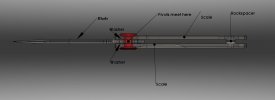Here is a fairly simple explanation WHY they can't send washers to you on a Sebenza but may on an Inkosi or Umnumzaan.
The example below is of an Umnumzaan from the side looking through the knife- Let's just for imagination purposes say that it's a Sebenza although the Umnumzaan is adjustable.
The blade+washer thickness MUST equal the backspacer thickness when broken in..but each one of these has a target thickness with a tolerance high and low. All parts have this tolerance or deviation from nominal that is acceptable before function is affected.
On the Sebenza, the pivot fasteners meet at the center when tightened down. Ideally, you should not have blade play or excessive tightness.
The things that control the pivot tightness at in the fastener (red parts below). Length of the contact face on the ends to the chamfer on the bottom side of the fastener. The depth of the chamfer in the scale (scale thickness is a minor function of this as keeping the depths the same have an affect when machining too)
The thickness of the backspacer is fairly well controlled. The washers are made from stock that is chemically machined..but STOCK has a different connotation because it's allowed to have variance in thickness as well. It could be + or - .001 depending on supplier. That is a huge number considering the rest of the tolerances.
The scales and the blade must be flat, but have a little deviation from nominal allowed. Perfect flatness, parallelism etc in a production environment is a bit tough to achieve.
Combine all these things and you have a reason to hand fit washers. It's not just slap it together.
I can go through some more detail a little later if needed as I understand that some of this may be a little confusing and may not make sense. Ask if you have a question and I will try to answer that for you.
View attachment 791553



